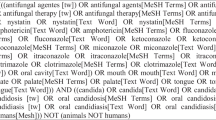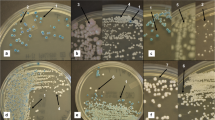Abstract
The oral cavity is a significant niche of the human microbiome and a gateway for the microbiota in many other human body sites. As a result, understanding the oral microbiota has broad implications for the prevention and management of human infectious diseases. Opportunistic yeast infections are among the most prevalent fungal infections of humans, and most opportunistic yeast pathogens are common residents of the oral mucosa. However, relatively little is known about the drug susceptibility profiles of oral yeasts. Here, we report the species distribution and patterns of antifungal susceptibility profiles among 313 yeasts isolated from the oral cavities of 301 asymptomatic hospitalized patients in Hainan Province in southern China. These yeasts were tested for their susceptibilities to the following five drugs: amphotericin B, fluconazole, itraconazole, ketoconazole, and fluorocytosine. Since none of the sampled hosts had taken any antifungal drugs at least 3 months before samples were taken, we hypothesized that little or no drug resistance should be observed. Contrary to our expectations, our analyses identified that 29 % (91/313) of the isolates were resistant to at least one drug and 14.3 % (45/313) were resistant to two or more of the five common drugs. The potential sources of the observed resistance were discussed.
Similar content being viewed by others
References
Brown GD, Denning DW, Gow NA, Levitz SM, Netea MG, White TC. Hidden killers: human fungal infections. Sci Transl Med 2012; 4:165rv13.
Fisher MC, Henk DA, Briggs CJ, Brownstein JS, Madoff LC, McCraw SL, Gurr SJ. Emerging fungal threats to animal, plant and ecosystem health. Nature. 2012;484:186–94.
Pfaller MA, Diekema DJ. Epidemiology of invasive candidiasis: a persistent public health problem. Clin Microbiol Rev. 2007;20:133–63.
Odds FC. Candida and candidosis. London: Bailliere Tindall; 1988.
Pfaller MA, Moet GJ, Meser SA, Jones RN, Castanheira M. Candida bloodstream infections: comparison of species distributions and antifungal resistance patterns in community-onset and nosocomial isolates in the SENTRY Antimicrobial Surveillance Program, 2008–2009. Antimicrob Agents Chemother. 2011;55:561–6.
Lockhart SR, Iqbal N, Cleveland AA, Farley MM, Harrison LH, Bolden CB, Baughman W, Stein B, Hollick R, Park BJ, Chiller TM. Species identification and antifungal susceptibility testing of Candida bloodstream isolates from population-based surveillance studies in two U.S. cities from, 2008 to 2011. J Clin Microbiol. 2012;50:3435–4342.
Rodloff AC, Koch D, Schaumann R. Epidemiology and antifungal resistance in invasive candidiasis. Eur J Med Res. 2011;16:187–95.
Ma CF, Li FQ, Shi LN, Hu YA, Wang Y, Huang M, Kong QQ. Surveillance study of species distribution, antifungal susceptibility and mortality of nosocomial candidemia in a tertiary care hospital in China. BMC Infect Dis. 2013;13:337.
Pemán J, Cantón E, Linares-Sicilia MJ, Roselló EM, Borrell N, Ruiz-Pérez-de-Pipaon MT, Guinea J, García J, Porras A, García-Tapia AM, Pérez-Del-Molino L, Suárez A, Alcoba J, García-García I. Epidemiology and antifungal susceptibility of bloodstream fungal isolates in pediatric patients: a Spanish multicenter prospective survey. J Clin Microbiol. 2011;49:4158–63.
Asmundsdottir LR, Erlendsdottir H, Gottfredsson M. Nationwide study of candidemia, antifungal use, and antifungal drug resistance in Iceland, 2000 to 2011. J Clin Microbiol. 2013;51:841–8.
Pfaller MA, Messer SA, Woosley LN, Jones RN, Castanheira M. Echinocandin and triazole antifungal susceptibility profiles for clinical opportunistic yeast and mold isolates collected from 2010 to 2011: application of new CLSI clinical breakpoints and epidemiological cutoff values for characterization of geographic and temporal trends of antifungal resistance. J Clin Microbiol. 2013;51:2571–81.
Bonfietti LX, Szeszs MW, Chang MR, Martins MA, Pukinskas SR, Nunes MO, Pereira GH, Paniago AM, Purisco SU, Melhem MS. Ten-year study of species distribution and antifungal susceptibilities of Candida bloodstream isolates at a Brazilian tertiary hospital. Mycopathologia. 2012;174:389–96.
Carvalhinho S, Costa AM, Coelho AC, Martins E, Sampaio A. Susceptibilities of Candida albicans mouth isolates to antifungal agents, essentials oils and mouth rinses. Mycopathologia. 2012;174:69–76.
Nelson KE, Madupu R, Szpakowski S, Goll JB, Krampis K, Methe BA. Next-generation sequencing, metagenomes, and the human microbiome. In Xu J editor. Next-generation sequencing: current technologies and applications. Norfolk: Caister Academic Press, pp. 141–155.
Xu J, Mitchell TG. Geographic differences in human oral yeast flora. Clin Infect Dis. 2003;36:221–4.
Wang H, Xu J, Guo H, Wu J, Yi G, Pei H, Niu L, Li Y. Patterns of human oral yeast species distribution on Hainan Island in China. Mycopathologia. 2013;176:359–68.
Belda-Ferre P, Alcaraz LD, Cabrera-Rubio R, Romero H, Simón-Soro A, Pignatelli M, Mira A. The oral metagenome in health and disease. ISME J. 2012;6:46–56.
Ghannoum MA, Jurevic RJ, Mukherjee PK, Cui F, Sikaroodi M, Naqvi A, Gillevet PM. Characterization of the oral fungal microbiome (Mycobiome) in healthy individuals. PLoS Pathog. 2010;6:e1000713.
Niimi M, Firth NA, Cannon RD. Antifungal drug resistance of oral fungi. Odontology. 2010;98:15–25.
Xu J, Ramos A, Vilgalys R, Mitchell TG. Clonal and spontaneous origins of fluconazole resistance in Candida albicans. J Clin Microbiol. 2000;38:1214–20.
Schoch CL, and the Fungal Barcode Consortium. Nuclear ribosomal internal transcribed spacer (ITS) region as a universal DNA barcode marker for Fungi. Proc Natl Acad Sci USA 2012; 109:6241–6246.
Luo C, Feng L, Dai HZ. Application of antifungal agents in 6 cities along the Yangzi River from 2005 to 2007. Chin J New Drugs Clin Remedies. 2009;10:785–90.
Li J. Analysis for usage of antifungal drugs from outpatient pharmacy. Strait Pharm J. 2012;24:258–9.
Institute CaLS. M44-A2 Reference method for antifungal disk diffusion susceptibility testing of yeasts; approved guideline, second edition. Clinical and Laboratory Standards Institute. Wayne, PA. 2009.
Anonymous. NEO-SENSITABS User’s guide in antifungal susceptibility testing of yeast, Rosco Diagnóstica A/S, Denmark. 2011.
Sokal RR, Rohlf FJ. Biometry: the principles and practices of statistics in biological research. 2nd ed. New York: Freeman and Company; 1981.
Wu CJ, Lee HC, Yang YL, Chang CM, Chen HT, Lin CC, Lee NY, Chu WL, Hsieh LY, Wang YL, Lauderale TL, Tseng FC, Ko NY, Ko WC, Lo HJ. Oropharyngeal yeast colonization in HIV-infected outpatients in southern Taiwan: CD4 count, efavirenz therapy and intravenous drug use matter. Clin Microbiol Infect. 2012;18:485–90.
Jung SI, Shin JH, Song JH, Peck KR, Lee K, Kim MN, Chang HH, Moon CS, Korean Study Group for Candidemia. Multicenter surveillance of species distribution and antifungal susceptibilities of Candida bloodstream isolates in South Korea. Med Mycol. 2010;48:669–74.
Mokaddas EM, Al-Sweih NA, Khan ZU. Species distribution and antifungal susceptibility of Candida bloodstream isolates in Kuwait: a 10-year study. J Med Microbiol. 2007;56:255–9.
Monk BC, Goffeau A. Outwitting multidrug resistance to antifungals. Science. 2008;321:367–9.
Zhang WJ, Jiang FB, Ou JF. Global pesticide consumption and pollution: with China as a focus. Proc Intl Acad Ecol Environ Sci. 2011;1:125–44.
Chowdhary A, Kathuria S, Xu J, Sharma C, Sundar G, Singh PK, Gaur SN, Hagen F, Klaassen CH, Meis JF. Clonal expansion and emergence of environmental multiple-triazole-resistant Aspergillus fumigatus strains carrying the TR34/L98H mutations in the cyp51A gene in India. PLoS ONE. 2012;7:e52871.
Chowdhary A, Kathuria S, Xu J, Meis JF. Emergence of azole resistant Aspergillus fumigatus strains due to agricultural azole use creates an increasing threat to human health. PLoS Pathog. 2013;9:e1003633.
Anonymous. Market analyses of antifungal drugs. Guangzhou Pharmaceutical Info Limited (www.menet.com.cn). Guangzhou, China. 2011.
Ásmundsdóttir LR, Erlendsdóttir H, Haraldsson G, Guo H, Xu J, Gottfredsson M. Molecular epidemiology of candidemia: evidence for smoldering nosocomial clustering. Clin Infect Dis. 2008;47:17–24.
Maganti H, Yamamura D, Xu J. Prevalent nosocomial clusters among causative agents for candidemia in Hamilton, Canada. Med Mycol. 2011;49:530–8.
Chowdhary A, Hiremath SS, Sun S, Kowshiki T, Randhawa HS, Xu J. Genetic differentiation, recombination and clonal expansion in environmental populations of Cryptococcus gattii in India. Environ Microbiol. 2011;13:1875–88.
Xu J, Vilgalys R, Mitchell TG. Lack of genetic differentiation between two geographic samples of Candida albicans isolated from patients infected with the Human Immunodeficiency Virus. J Bacteriol. 1999;181:1369–73.
Wang H, Wang Y, Chen J, Zhan Z, Li Y, Xu J. Oral yeast flora and their ITS sequence diversity among a large cohort of medical students in Hainan, China. Mycopathologia. 2007;164:65–72.
Acknowledgments
We thank the following people for helping with our sample collections: Leilei ZHANG, Fei LIU, and Yue DONG. Financial support for this project came from the Hainan Provincial Key Science Project (Grant numbers 090214 and 801010); the Department of Education of Hainan Province (Hjkj2012-36); and a training grant from Hainan Medical College (HY2010-009).
Author information
Authors and Affiliations
Corresponding authors
Rights and permissions
About this article
Cite this article
Wu, J., Guo, H., Yi, G. et al. Prevalent Drug Resistance Among Oral Yeasts from Asymptomatic Patients in Hainan, China. Mycopathologia 177, 299–307 (2014). https://doi.org/10.1007/s11046-014-9747-3
Received:
Accepted:
Published:
Issue Date:
DOI: https://doi.org/10.1007/s11046-014-9747-3




